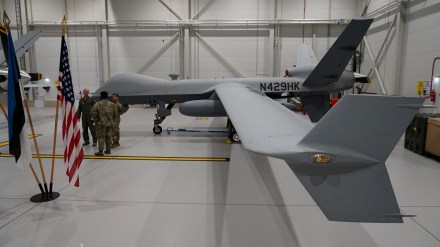Over the next few days, the Ministry of Defence is expected to receive the Letter of Acceptance (LoA) from the Biden administration for the delivery of 31 MQ-9B Sea Guardian drones to India.
Sources have confirmed to Financial Express Online that the LoA is set to be sent to New Delhi shortly, and this will set the ball rolling for the next step — price negotiations. The US Congress is expected to put its stamp of approval soon.
Financial Express Online has reported previously that approval has been given for 31 MQ-9B drones and out of these 15 Sea Guardian drones are for the Indian Navy and eight each for the Indian Air Force (IAF) and the Indian Army (IA). These will be procured from the US under the government-to-government framework by March this year.
Officials from both sides are expected to hold a final series of negotiations related to the procurement of these drones once Washington responds to India’s Letter of Request (LoR). These drones will be from General Atomics Us based defence major.
These long-endurance ‘hunter-killer’ drones will help the Indian armed forces strengthen their surveillance apparatus, especially along the Line of Actual Control (LAC) with China. And in the Indian Ocean as well as the coastal line.
Though the estimated cost of the deal is expected to be lower than USD 3 billion, the price negotiation will start once the LoA is received. It is understood that the issue of India’s proposed procurement of the drones figured during US Defence Secretary Lloyd J Austin’s talks with Defence Minister Rajnath Singh in Delhi last November.
At a select media briefing in New Delhi, Austin had indicated that the final deal will be announced at the right time. Financial Express Online had reported previously that these high-altitude long-endurance drones are capable of remaining airborne for over 35 hours and can carry four Hellfire missiles and around 450 kgs of bombs.
In a strategic move, the Indian Navy, in 2020, leased two MQ-9B Sea Guardian drones from General Atomics for one year, focusing on surveillance in the Indian Ocean. This lease has been subsequently extended, underlining the drones’ continued importance in bolstering India’s maritime security. And these two drones are being deployed by the Indian Navy to fight piracy attempts in the Arabian Sea, and Gulf of Eden.
India is expected to pay just USD 99 million for each MQ-9B drone, a significant reduction compared to the USD 161 million spent by the UAE in previous acquisitions. The US previously acquired 16 drones at USD 69 each, but these lacked vital components like sensors, weapons, and certification, making up 60-70% of the total cost.
The advantageous pricing for India is influenced by the country’s large deal size and the manufacturer’s ability to recover initial investments from earlier transactions. However, the potential inclusion of indigenous radars and missiles might lead to a revaluation of costs, highlighting the complexities in such acquisitions.
The Indian Air Force and Army consistently back these acquisitions, emphasizing the importance of technological expertise. India aims for a 15-20 percent technology transfer, manufacturing major components domestically, including engines, radar processor units, avionics, sensors, and software.
Pending final approval from both governments, India intends to purchase 11 ready-made drones initially, with the rest assembled domestically. These MQ-9B drones, renowned for their high-altitude long-endurance capabilities, play a crucial role in boosting India’s surveillance abilities, effectively monitoring both land and maritime boundaries.
